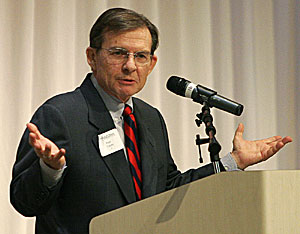 |
|
MATT ROBLES/Arizona Daily Wildcat
|
UA President Peter Likins gives his State of the University address in the Student Union Memorial Center last week. Likins is the 15th highest-paid public university president in the nation.
|
|
|
By Natasha Bhuyan
Arizona Daily Wildcat
Monday, November 29, 2004
Print this
Study says UA president one of the highest paid among public institutions
UA President Peter Likins is one of the highest-paid public university presidents in the nation, coming in at No. 15, according to a study released by the Chronicle of Higher Education Nov. 19.
Likins' total compensation package is $503,394, but Likins said he does not believe the president of a public university should make more than half a million dollars.
Therefore, Likins said he annually returns $60,000 of his salary to the university in various areas, such as scholarships, the New Start Summer Program and the Women's Plaza of Honor.
Of his total compensation, $285,000 is in state-based pay. The state also provides Likins $8,394 for a car and $46,993 for a house. Likins will receive $163,007 in deferred compensation.
But although the UA president ranks No. 15 in salary, the university faculty salary is well below the 20th percentile nationally, and it would take $135.8 million to be on the same level as other universities.
Wanda Howell, vice chair of the Faculty Senate and a university distinguished professor, said it is clear UA faculty are "woefully underpaid," but those who believe Likins is paid too much in light of the faculty salary crisis are being naïve since the president's salary is unrelated to faculty members.
"Let's give the guy his due," Howell said.
Howell believes administrators at the UA are attempting to address the salary crisis by setting up a special fund for faculty retention, but the UA is far from its goal of being in the 50th percentile.
"It's never going to happen - the best that we can hope for are small incremental raises," Howell said. "The $1,000 (raises) are nowhere near the rate of inflation - we are actually losing money every year."
John Wilson, director of Decision and Planning support, said compared to other institutions throughout the past few years, the UA faculty salaries have steadily decreased. Last year, however, the decision package gave faculty salaries a slight boost, Wilson said.
When Likins joined the UA after being president of Lehigh University, a private college in Pennsylvania, he took an $80,000 pay cut, going from $275,000 to $195,000.
"I didn't come here for the money," Likins said.
However, the Arizona Board of Regents gave Likins a salary raise after offering Arizona State University President Michael Crow - then a vice provost at Colombia University - more than half a million dollars to come to ASU.
In the study, Crow is ranked two spots above Likins, with a total compensation of $518,394. Northern Arizona University President John Haeger earns $260,000.
The highest-paid president of a public institution is the University of Washington's Mark A. Emmert at $762,000, while the highest-paid private institution president is Johns Hopkins University's William R. Brody, with $897,786.
According to the study, the median compensation for pubic university presidents this year is $328,400.
Gale Tebeau, assistant executive director for financial affairs, said in determining Likins salary, the Regents considered numerous factors, such as what other universities were paying their presidents, how much he got paid in the past and what he had contributed to the university.
"It's all market-driven," Tebeau said.
Tebeau said the Regents originally offered Likins a salary to match Crow's, but Likins opted for a lower figure.
Dick Roberts, director of the budget office, said he is a proponent of compensating hard work, and believes Likins has earned his salary due to his ability and dedication, working 17 to 18 hours per day.
"I know I get e-mails from him at 3:15 in the morning," said Roberts.
Despite the figures, Likins is not the highest-paid employee at the UA. That title belongs to men's basketball coach Lute Olson, who earns a salary of $700,000, with a possible $355,000 in performance incentives.
Olson would also receive $175,000 if the men's basketball team won the national title, on top of additional incentives such as a high team GPA, high player graduation rate and coaching awards.
Men's football coach Mike Stoops also earns more than Likins, with a salary of $650,000 a year plus the possibility of $630,000 in performance incentives. Like Olson, Stoops will get extra money if the team does well academically and athletically, and also if there is a high fan turnout.
Both coaches' incentives could push them past $1 million a year.
Ashley Donald, a pre-pharmacy freshman, called the salary discrepancy between the coaches and Likins ridiculous.
Donald said although they are important to the university, athletic coaches do not deserve such high salaries.
Instead, Donald said faculty members, who work with students the most, should be paid more.
But Tebeau said the figures are reflective of the economic market.
"If you look around the country, that's what they (coaches) are making," Tebeau said. "If you want to get somebody good, you've got to pay them."
Bobby McCoy, a wide receiver for the men's football team, said he believes Stoops is a hardworking coach and good motivator who deserves his salary.
Under Stoops' leadership, McCoy said he can see the football team getting better.
Jessica Simms, a veterinary science freshman, said she is glad Likins gives back part of his salary to the university, but believes all of the non-faculty salaries are too high.
Another top earner at the UA is Dr. Jack Copeland, UA's internationally recognized chief of cardiovascular and thoracic surgery, co-director of the University of Arizona Sarver Heart Center and developer of the CardioWest Total Artificial Heart.
Copeland, whose artificial heart gained FDA approval last month, also receives more than Likins, at $561,446 a year.
